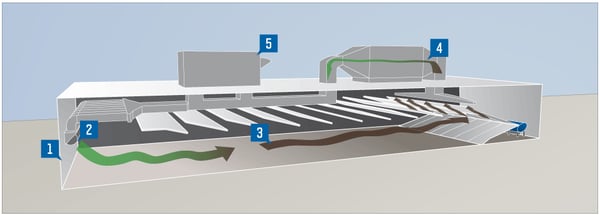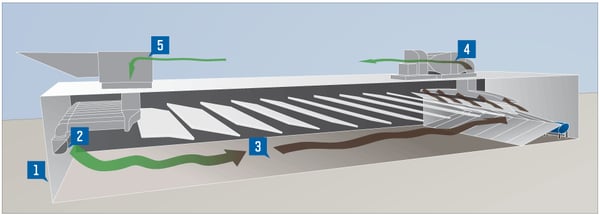Shooting ranges are inherently dangerous places. After all, without taking proper precautions or implementing standard safety design features, there’s always the potential risk that a projectile could strike someone utilizing a shooting range.
But as scary as that might be, there is actually another—equally dangerous, yet invisible—threat facing anyone who enters a shooting range.
Lead dust exposure.
Shooting firearms loaded with lead bullets or lead-containing primer expels lead particles into the air through gun smoke. Then, if the bullet hits a hard-surfaced bullet trap, even more of these dangerous microscopic lead particles can be released into the air. If not properly captured, the lead will then be dispersed throughout the air, where it can be inhaled or ingested by those within the range.
Once in a person’s system, lead enters the bloodstream when it can create unsafe levels that can damage internal organs and lead to a variety of other chronic health issues—even death. It is estimated that in the United States alone, lead contamination could be responsible for more than 400,000 deaths each year.
Because of this, it is critically important that all shooting ranges implement a comprehensive system of integrated controls, air filters, maintenance procedures, and ultimately the safe disposal of captured lead to ensure the safety of those both on the inside and the outside of the range.
To help you make the best, most well-informed purchase for your shooting range, we’ve drawn upon our unique partnership with Action Target—one of the industry’s leading suppliers of shooting range systems, and our partner in the Arcas series of modular shooting ranges. We’ve compiled some basic information you can refer to when building your shooting range’s ventilation system.
Recirculating ventilation systems vs. purge ventilation system
There are many different types of ventilation systems on the market offered by a variety of manufacturers. For example, at Action Target they offer both recirculating ventilation systems and purge ventilation systems.

Recirculating Ventilation Systems
Recirculating systems work exactly how they sound; they take the air that is already in the range, run it through a series of filters and then recirculate it. Because this type of system utilizes air that has already been heated or cooled, they use less energy and can be set up to remove excess humidity from inside the range.
 Purge Ventilation Systems
Purge Ventilation Systems
On the other hand, a purge system draws air from outside the range, filters it, and releases the clean air back into the atmosphere. To ensure overall air quality, purge systems utilize prefilters that are changed monthly and HEPA (>High Efficiency Particulate Air) filters that are changed every 2,400 hours.
Both recirculating and purge ventilation systems create negative air pressure that draws hazardous dust away from the shooter and toward the bullet trap. In addition, these systems provide:
- Laminar diffusion--clean air is introduced to the range from behind the shooting line.
- Range exhaust fan--filters contaminated air to keep the area around the range clean.
- Make up air unit--draws and filters air from the atmosphere and introduces it into the range. (In recirculating systems, this air usually accounts for only about 20 percent of the total air used by the system)
Filters and range ventilation
Keeping the air moving is one thing but ensuring that it’s clean is another. That’s where filters come in.
Typically, whichever ventilation system you choose will feature an entire series of filters to capture even the finest lead particulates. One such option is a triple filtration method. It contains a prefilter, a mid-filter, and a HEPA filter. The first two collect the majority of particles, thereby protecting the HEPA filter from wear and tear to provide a longer lifespan.
Action Target, however, recommends a bag filtration system that combines a 22” to 30” bag filter and a 12” HEPA filter to prevent 99.97 percent of particles from entering the atmosphere. This system results in less frequent replacement due to a larger surface area that can hold more particles, requires less storage space, is easier to replace, and reduces hazardous waste by cutting down on the total number of filters needed.
Both bag and HEPA filters come in a variety of options and price ranges, based on overall range use. And while higher quality filters may require a higher initial cost, they often pay off in the long run because not only do these filters perform better and last longer; they are also generally much more energy efficient.
Dealing with waste in range ventilation systems
As hazardous waste generators, shooting ranges are required by state and federal law to ensure the responsible handling, transportation, and disposal of waste at a site approved by the Resource Conservation and Recovery Act (RCRA). Failure to do so could result in significant penalties—even criminal charges. Luckily some suppliers, including Action Target, will pick up and dispose of contaminated filters for you, to both alleviate stress and ensure compliance. These suppliers will even provide documentation to prove that they have properly disposed of the materials to protect you from potential fines.
Learning more about shooting ranges
Lead dust exposure is a serious—and possibly deadly—threat facing anyone who utilizes an indoor shooting range. To protect yourself, others, and the environment, it is important that you:
- Install a top-of-the-line ventilation system
- Regularly maintain the ventilation system
- Dispose of all waste is correctly
By partnering with a reputable supplier of shooting range ventilation systems, you can avoid not only the health risks associated with lead dust exposure but potential fines and even criminal charges.
If you’d like to learn more about shooting range ventilation systems, contact us today. Or read more about our exclusive line of Arcas Modular Small Arms Ranges developed in partnership with Action Target.